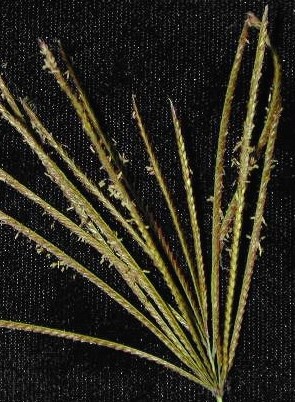Scientific name: Chloris gayana Kunth
Common name: Rhodes grassFamily: PoaceaeOrigin:Native to Africa. Habit:A perennial grass, growing to 1.5 m tall, with both upright and creeping (ie. stoloniferous) stems. Habitat:A weed of roadsides, footpaths, disturbed sites, railways and cultivation. Widely cultivated as a pasture grass. General description:Stems and leavesThe stems (culms) are either erect or creeping (ie. stoloniferous and rooting at the nodes). Leaf blades are linear (8-28 x 0.2-0.9 cm in size) and hairless (glabrous). The ligule is a flattened membrane about 0.5 mm long with longer hairs (cilia) on top and at the edges. Flowers and fruitThe inflorescence is a digitate or sub-digitate arrangement of 8-17 spikes each about 7-10 cm long. The greenish-brown spikes are loosely arranged and sometimes droop. Each spike has a large number of spikelets that usually contain three or four florets. Most of the florets are sterile with only the lowest in each spikelet usually producing a seed. Each spikelet has two very small and thin awns less than 4 mm in length. Distinguishing characteristics:A large grass with distinctive digitate or sub-digitate inflorescences with many spikes. Chloris virgata (feathertop Rhodes grass) is a closely related and similar species. However, this grass has feathery spikes that are borne in a more upright position. It's spikelets also have larger awns (5-10 mm long) and only two florets. Noxious status:Not noxious. Sources:Stanley, T.E. and Ross, E.M. (1983-1989). Flora of South-eastern Queensland. Volume 3. Department of Primary Industries, Brisbane. |
Brisbane
St Lucia, QLD 4072
+61 7 3365 1111
© 2009 The University of Queensland


